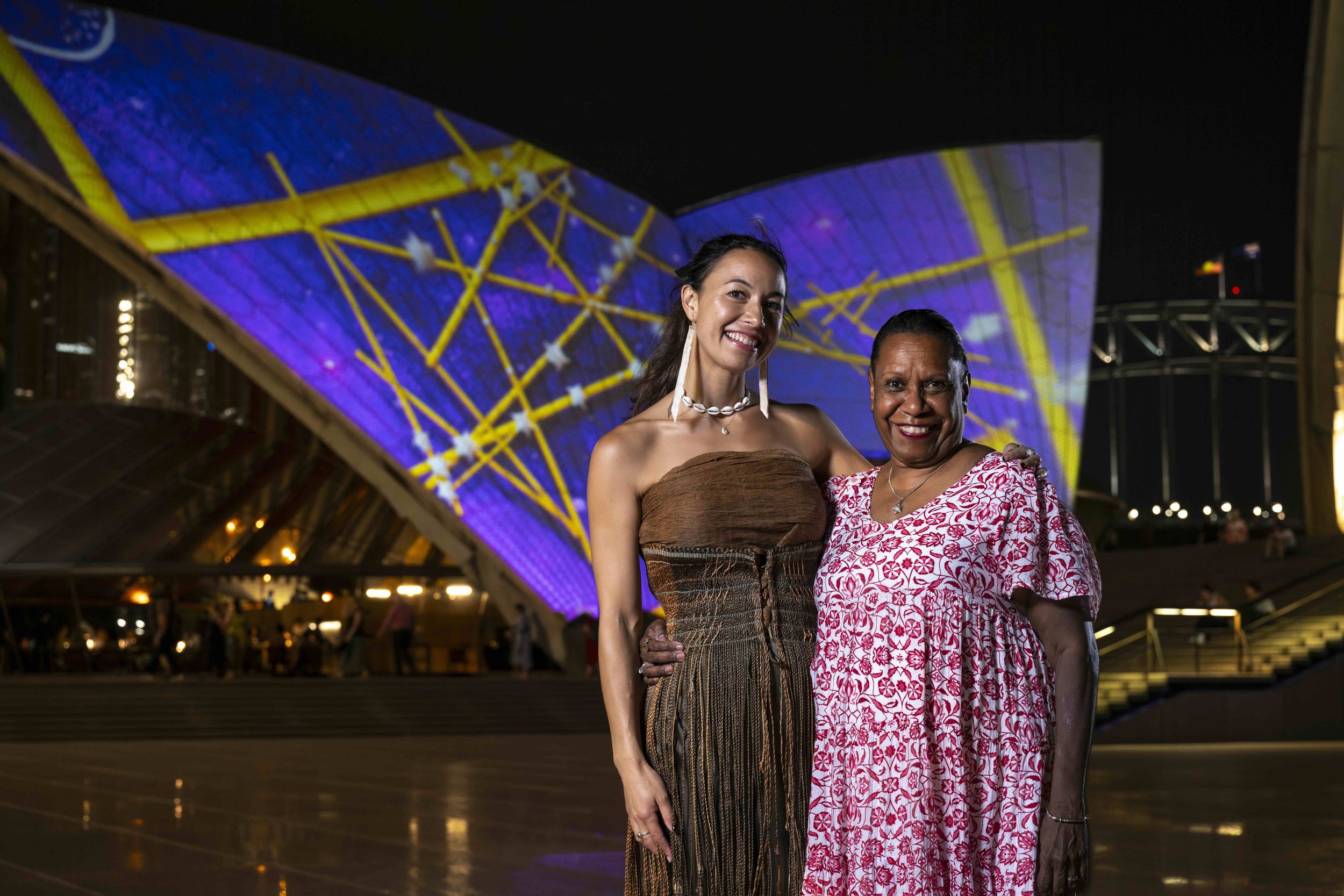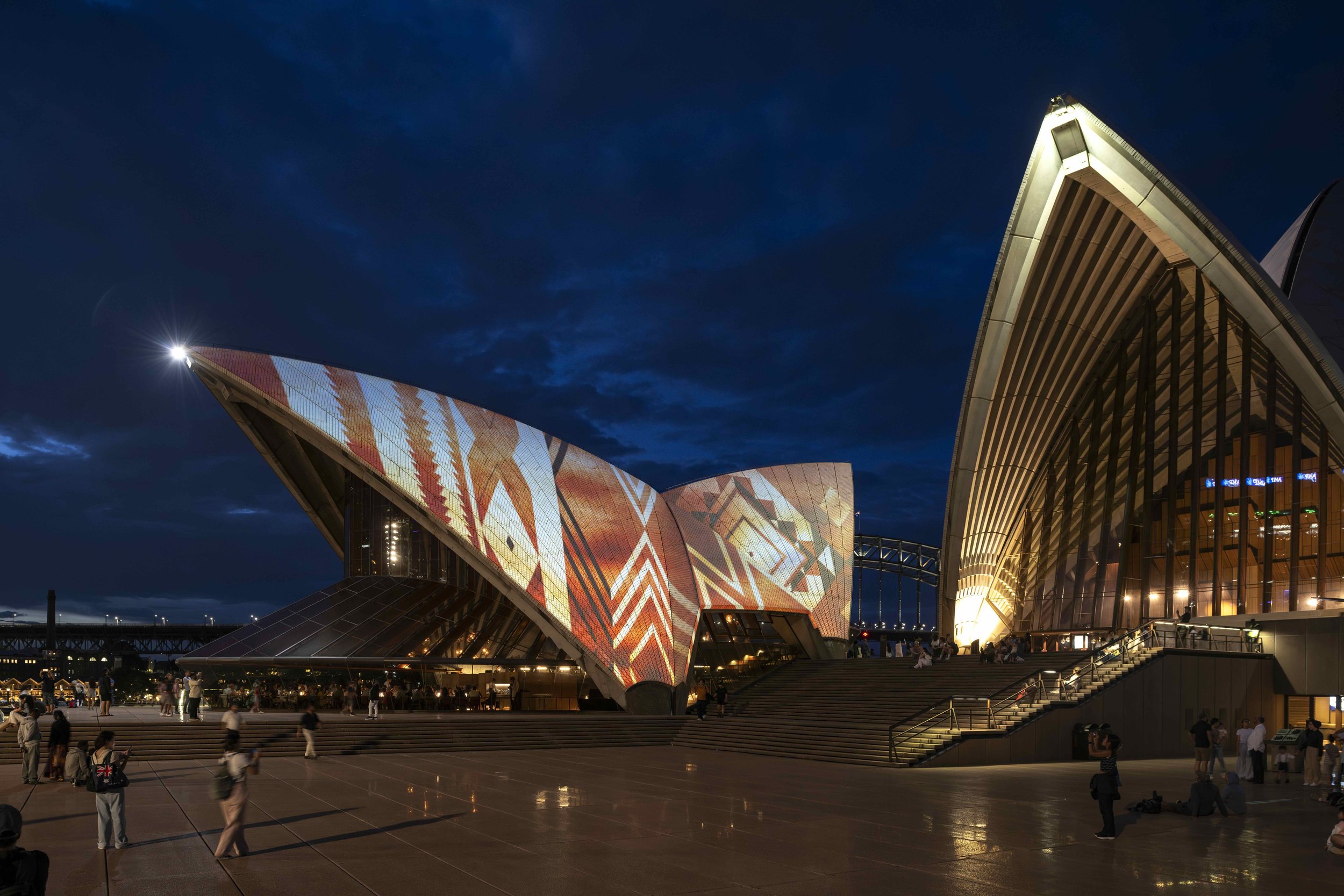Artists Gail Mabo and Nikau Hindin introduce their project for the Sydney Opera House
/Every night until 15 December 2024, Badu Gili: Celestial, a digital animation featuring works by Meriam artist Gail Mabo and Te Rarawa/Ngapuhi artist Nikau Hindin is being projected on to the Bennelong sails of the Sydney Opera House. The work is a joint commission by the Sydney Opera House, the Biennale of Sydney and the Fondation Cartier pour l’art contemporain.
Although they’re separated by a stretch of ocean, Mabo and Hindin share the same commitment to sharing First Nations stories and histories that are held in the stars through their art. Both Mabo’s bamboo and star-sand maps, and Nikau’s bark cloth kites and maps, carry traditional knowledge, which is now being showcased in a new way through animation. Celestial is an instalment of ‘Badu Gili’, the Opera House’s free, nightly light display of work by Indigenous artists.
“Tubowgule, where the Sydney Opera House stands today, has long been a meeting place for celebration, culture and community,” explains Michael Hutchings, Head of First Nations Programming at the Opera House. “‘Badu Gili’ continues this legacy, sharing both living and ancient stories told through vibrant animations projected onto one of the 20th century’s most iconic buildings. The ‘Badu Gili’ project, meaning ‘water light’ in the language of the traditional owners of the site, was initiated by our inaugural Head of First Nations Programming, Rhoda Roberts. Rhoda’s passionate advocacy and curation was instrumental in the project’s beginnings in 2017. Now in its fourth edition, Badu Gili is a pillar of the Opera House’s year-round First Nations program, demonstrating our commitment to fostering and celebrating the rich history and vibrancy of First Nations people and culture.”
Here, in conversation with Billie Phillips, Assistant Curator of the Biennale of Sydney, Gail Mabo and Nikau Hindin discuss how Badu Gili: Celestial came to life.
Billie Phillips (BP): Both your works deal with constellations. How did each of you learn about the stars and the stories that are depicted in your works?
Gail Mabo (GM): The star maps came from stories that my dad told me, which are the stories told throughout the Torres Straits, of Tagai. Tagai was our main God that we use to navigate across the Straits. And when you’re looking at Tagai, you’re looking at the whole sky. From the tip of Queensland, Australia to Papua New Guinea, that’s that small bracket of sky that we look at, and that’s where Tagai lies.
I also put in an acknowledgement to my children and their Koori heritage through the Emu Dreaming story, along with the Lamir Kuskir, or the Seven Sisters story, which you have from the Central Desert, but also in the Torres Straits. Lamir Kuskir refers to the wives of this old man who he banished to the sky. They sit above him, laughing, due to the things that he did wrong to them. ‘Poor fella, he still lives by himself. Look at him down there!’ they say. It’s been translated through dance and now I’ve translated it through a star story.
Nikau Hindin (NH): I first learnt about the stars when I was living in Hawai’i. I was learning about bark cloth practice at the same time I was learning about celestial navigation. The star maps that I create are a way for me to memorise our stars, our specific names for those stars, and where they rise on the horizon. The stars become markers for direction, so that we can locate ourselves in time and space. Then, when I returned to Aotearoa, the process of making star maps became even more important because I had to then translate the Hawaiian and English names into our Maori names and learn our Maori stories.
Since learning about celestial navigation, I’ve discovered more about the way that our stars change during different times of the year and how our stars have been used to record time. Indigenous peoples have observed stars throughout generations and possess an inherent understanding or knowing about time and an understanding that a single generation is brief and that the knowledge that I know about stars now is many, many generations old.
BP: Both of your works draw upon such a deep well of community and cultural knowledge. I know that in the making of this work you both engaged in a series of collaborations. What was it like for you when you saw your works being transformed from one medium into another?
GM: In the initial conversation I was trying to wrap my head around the idea of projecting onto the Sydney Opera House. I thought: ‘How are they going to animate the maps?’ When they first showed me the early animation of pulling it apart and putting it back together, I was amazed, I had this whole fascination with ‘What else can you do? What are you going to do with my stars?’
Later, when I was sleeping, I could hear ‘Requiem for Eli’, which is a sound piece by Nigel Westlake. There was a bit of music in there that just kept standing out. And it was grand, it was bigger, it could be big as a sky. So, when I awoke, I went to Nigel and I said, ‘There's a piece of work that you have’ and he knew exactly what it was and that it needed to be used for this. He went to his studio for a moment and through the speakers came the sound I wanted. We also needed the vocals of a male chant, so we approached David Bridie. I’ve worked with him on different things, he’s a writer and composer from Melbourne who works with people from Papua New Guinea.
NH: Having my kind of works on the Sydney Opera House is such a massive shift in scale, but also in material. My work is very physical and labour intensive and the materials are from our environment, whereas an animation is transient or intangible. So I really had to trust the animation process because I’m not an expert in making patterns move, so I enjoyed that exchange. In some aspects, I was quite specific with how I wanted the movement to happen because of the way that I interpret or understand how the stars move, and how I would like the maps to be read.
BP: What aspect of each other’s work resonates with you the most?
NH: I was left speechless at the way that the stories of our stars are told through Gail’s artwork and the conceptualisation of this vast space. How she creates something that’s tangible to interpret this vast, vast knowledge system.
And also, the stars. There are so many little things about scale in your work, which is really interesting. You’ve kind of gone from tiny to big, all from a tiny grain of sand. So, there’s this beautiful thread of scale that is really profound. I love that, Gail, you hold the stories of your people. You’re a Kaitiaki, or a guardian of those stories that are so old and so important.
GM: Thank you, Nikau. My mind is blown at what you’ve done. It’s absolutely beautiful. The first thing that gets me with your work is that sound. When I close my eyes, I drift to where you come from. I can see your kites flying around in my head. Then, I see your work unfolding: the beating of the cloth, to the beautiful patterns they become, to the kites that fly through the sky. Your work gives me a reason to go investigate a little bit more into your culture. One day I will come across to New Zealand and you can show me.
NH: You know it!
This is an edited extract from a longer conversation that was published in Art Monthly Australasia’s special edition about the 24th Biennale of Sydney. Buy a copy of that issue here.
Please note macrons in the Te Reo Maori terms do not appear on this webpage.





















